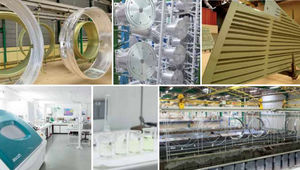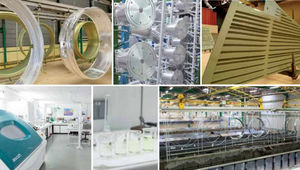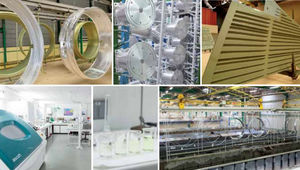
- Industrial machines and equipment
- Surface Treatment
- Sulfo-tartaric anodizing
- SGI - Société de Galvanoplastie Industrielle
Sulfo-tartaric anodizing aluminumfor aeronauticslarge series
Add to favorites
Compare this product
Characteristics
- Type
- sulfo-tartaric
- Type of substrate
- aluminum
- Applications
- for aeronautics
- Production method
- large series, medium series, small series, individual
- Certifications
- EN ISO 2409, NF EN 4704, ISO 9227
Description
Sulpho-tartaric anodic oxidation is the emanation of an Alenia patent improved by Airbus. The aim is to replace chromic anodic oxidation, (CAO).
It is generally performed in a bath containing about 40 g/l of sulphuric acid and 80g/l of tartaric acid, at a temperature of 35 to 40°C. The constant voltage is 14/15V. The cycles of approximately 25 minutes include a voltage rise of 5 minutes and then a steady state of 20 to 25 minutes. The sulpho-tartaric anodizing forms very thin layers, 2 to 7 µm (thicknesses similar to those formed during a CAO). It creates good corrosion resistance thanks to the adhesion of the paint films, painting is performed on an unsealed layer. Its influence on the fatigue characteristics is moderate (reduction in the order of 20 to 30% compared to the bare substrate, similar to that induced by a CAO).
Appearance: colourless to slightly iridescent
Thickness: 2 to 7 µm
Surface condition: slight degradation of the roughness
Reduction in fatigue: comparable to that of the CAO, depending on the alloy, may be compensated for by prior shot peening
Catalogs
No catalogs are available for this product.
See all of SGI - Société de Galvanoplastie Industrielle‘s catalogsOther SGI - Société de Galvanoplastie Industrielle products
Treatment by electrolytic conversion
Related Searches
- Anodic oxidation
- Aluminum anodic oxidation
- Painting
- Large series anodic oxidation
- Small series anodic oxidation
- Medium series anodizing
- Painting on metal
- Hard anodizing
- Automotive anodic oxidation
- Industrial anodizing
- Aeronautic anodic oxidation
- Individual anodizing
- Sulfuric anodic oxidation
- Chromic anodic oxidation
- Painting on steel
- Pickling
- Aeronautic painting
- Anodizing for the food industry
- Painting on aluminum
- Steel pickling
*Prices are pre-tax. They exclude delivery charges and customs duties and do not include additional charges for installation or activation options. Prices are indicative only and may vary by country, with changes to the cost of raw materials and exchange rates.





